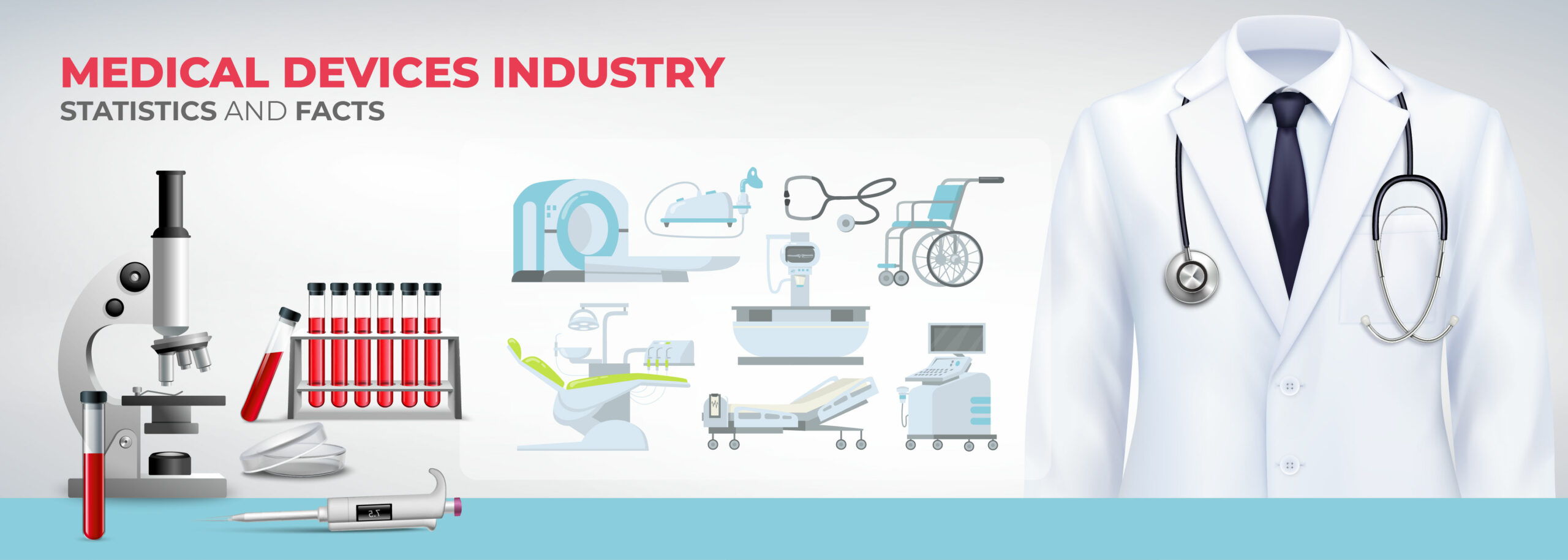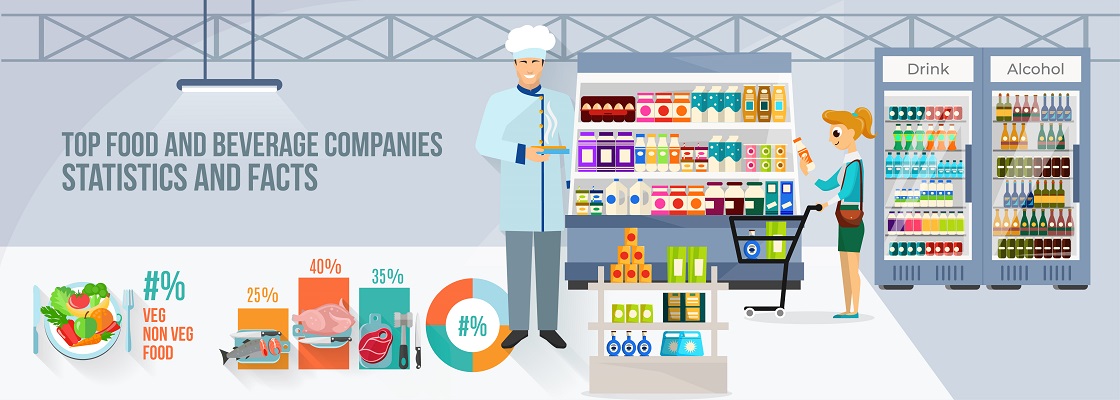Medical Device Industry Statistics: A medical device is any instrument, appliance, implement, machine, apparatus, implant, vitro reagents, software, or material that the manufacturer intends to use alone or in combination for a medical purpose. In this section, we cover the top medical device brands and companies and offer detailed information regarding the date of establishment, headquarters, CEO, subsidiaries, product offerings, employee count, geographic footprint, revenue growth, segment revenue growth, and other financial information. In addition, this section comprises medical technology industry statistics and a graphical representation of the region and country revenues on a yearly and quarterly basis, apart from demographic facts, fun facts, historical events, recent developments, strategies, acquisitions, upcoming product launches, new additions, strategy, and other industry-related news.
Medical devices are essential for standard medical procedures, such as bandaging a sprained foot, diagnosing HIV/AIDS, and implanting an artificial hip. These health technologies can diagnose and monitor illness and help disabled patients and intervene in and treat chronic diseases. Medical devices can be used in many settings. They are used by doctors, nurses, paramedic staff, and patients in remote clinics. Also, opticians, dentists, and healthcare professionals work in advanced medical facilities for palliative and prevention care.
Any device intended to be used in medical settings is a medical device. Potential hazards exist when a device is used for medical purposes. Therefore, medical devices must be proven safe and effective with reasonable assurance before being allowed to be sold in their respective countries. The amount of testing necessary to determine the safety and efficacy of the device is generally higher when there is a greater risk. Additionally, the risk associated with the device increases must be reflected in the patient’s potential benefit.
It is essential to access high-quality, affordable, and appropriate health products to improve universal health coverage, address medical emergencies, and promote healthier people.
There are currently 2 million types of medical devices worldwide. These devices can be categorized into over 7000 generic groups. Medical devices can include any device, instrument, implement, machine, or appliance intended to be used for medical purposes. According to Statista, Revenue in the Medical Devices segment is projected to reach US$435.70bn in 2022.
Total 3 Classes of Medical Devices
Class I
Devices with moderate to low risk to patients and users are classified as Class I medical devices. Today, 47% are medical devices that fall within this category. 95% of these devices are exempted from regulatory review. A pre-market notification application is not required for devices within the exempted Class-I category. FDA clearance is not required to market the device in the US. The manufacturer must register their establishment with FDA and list their generic product. These include bedpans, elastic bandages, and manual stethoscopes.
Class II
Devices classified as Class II are devices that pose a moderate-to-high risk to patients and users. This category covers 43% of medical devices. The majority of medical devices fall under the Class II category. Some Class II devices include powered wheelchairs and pregnancy test kits.
Class III
Devices classified as Class III are medical devices that pose a risk to the user and patient. These devices are used to sustain or support life and can be implanted or pose an unreasonable risk of injury or illness. They account for 10% of all medical devices that are regulated by the FDA. Implantable pacemakers, breast implants, and other Class III devices are examples of Class III devices.
North America Medical Device Industry:
The major markets for the region’s healthcare industry are Canada and the United States of America. Due to its large healthcare and R&D investments, the U.S. market dominated this area. The market expansion will be further supported by the fact that the average annual growth rate for healthcare spending in the U.S. is 5.5% per year between 2022-2026.
Canada’s market will also flourish, as 71% of total healthcare spending is funded by the government. This market faces many challenges, including strict government regulations for medical device approval and stiff competition from countries like Japan, Germany, and the Netherlands. In 2022, the medical device segment is projected to reach US$ 165.30 Bn. In global comparison, most revenue will be generated in the United States (US$150 bn in 2022).
This statistic displays the 2020 revenue of the 10 largest U.S. medical tech companies. Medtronic was the most successful company with nearly 29,000 million U.S. Dollars. Johnson & Johnson had a revenue of around 23,000 million U.S. dollars.
Europe Medical Device Industry:
At a 3.7% CAGR, the European market for medical devices is expected to reach USD 182 billion by 2022. This market is driven by the growing geriatric population, established and large medical technology industries, increasing number and complexity of surgical procedures, cost-containment in healthcare, and funding for research and product development.
Asia Pacific Medical Device Industry:
At a 6.5% CAGR, the APAC market for medical devices is expected to reach USD 100 billion by 2022. The Asia Pacific is an ideal region to source and manufactures medical devices for major medical device manufacturers. Recognizing the value of such devices for patients, hospitals, and payers has supported the growth of medical devices in Asia-Pacific. The medical device industry is also supported by the increasing use of routine healthcare checks and technological advancements in medical devices.
The market is expected to expand significantly in the future due to the increasing demand for minimally invasive medical treatments, government support for medical device development, and research and development in advanced medical devices. The market growth is being slowed by a lack of medical facilities in low- and middle-income countries in the Asia Pacific.
South America Medical Device Industry:
The South American medical device market is expected to reach USD 18 billion by 2022, growing at a CAGR of 5.4 percent%. During the forecast period, the rapid growth in the number of medical facilities, the rapid growth of the elderly population, the rapid growth in emerging markets, especially in underdeveloped countries, rapid technological advancement, and increased health care spending are expected to drive the growth of the South American medical devices market.
The Middle East & Africa Medical Device Industry:
The Middle East & Africa Medical Devices market is expected to reach US$ 18,455 million in 2022. It is projected to grow at a CAGR of 4% between 2020 and 2027. The healthcare sector in the Middle East & Africa region has seen significant growth. The Middle East and Africa region are comprised of three countries: Saudi Arabia, United Arab Emirates (UAE), and South Africa. Market forces include increasing government initiatives, increasing research and development activities, as well as the increasing number of market participants in the region. Saudi Arabia offers several incentives to encourage the domestic manufacturing of medical devices. This can help drive market growth.
Key Players:
1. Medtronic Inc.
Medtronic, one of the world’s largest medical device manufacturers, develops and produces therapeutic medical devices for chronic conditions. Its products include pacemakers, defibrillators, and heart valves. It sells its products to doctors and healthcare institutions in the United States as well as overseas. Nearly 50% of company sales are made abroad.
2. Johnson & Johnson
The company was established in 1886 and headquartered in The U.S. The market capitalization of the pharmaceutical and consumer goods company is $428.7 million. They were the first to approve the use of a vaccine in the United States and were included in the TIME100Most Influential Company List for 2021.
Tylenol and Band-Aid are some of Johnson & Johnson’s most well-known consumer brands. Johnson & Johnson is a leader in medical device products, research and development, pharmaceutical manufacturing, and consumer level.
This statistic displays the global sales of top medical equipment and supplies companies in 2021. Johnson & Johnson, the world’s largest medical equipment and supplies company, had sales of 82,600 billion dollars in 2021.
Johnson & Johnson’s medical diagnostics and medical devices segment made 9,800 million U.S. Dollars through its surgery franchise in 2021. The segment’s second-largest field was orthopedics, with 8,600 billion U.S. Dollars in that year.
3. Siemens Healthineers
Siemens Healthineers, Europe’s largest engineering conglomerate, is the medical division of Siemens AG. It makes and markets medical equipment that diagnoses and treats disease. In 2016, the company’s name was changed from Siemens Healthcare to Siemens Healthineers. Siemens is a world-leading supplier of technology to healthcare and a leader in medical imaging and laboratory diagnostics. Siemens produces CT scanners, MRI systems, and PET/CT technology.
4. Danaher Corporation
Danaher is a leading provider of medical technology and health products. It offers products in life sciences, diagnostics, and environmental and applied. The company employs approximately 81,000 people worldwide, with 32,000 based in the United States.
The company’s life science and diagnostics divisions make up 62% of total company sales. This includes sales from multiple acquired companies such as Beckman Coulter and Radiometer.
5. Stryker Corporation
Stryker Corporation, a medical equipment company, develops and produces surgical and imaging technologies as well as patient handling equipment and emergency medical equipment. The company has locations worldwide in many states of the United States, including Switzerland, Sweden, Spain, and Norway.
Stryker has a wide range of products for the global orthopedic market. Stryker is active in all aspects of devices, but it has a strong focus on the intramedullary nails group and hip fixation.
6. Becton Dickinson & Co.
BD is a leading global company in medical technology that designs, manufactures, and sells medical instruments, reagents, and other devices. BD was founded in 1897 and has more than 30,000 employees in over 50 countries. It serves the healthcare industry, pharmaceutical industry, researchers in life sciences, and clinical laboratories. BD has been present in China and India since 1994.
BD products include intravenous catheters, needles, and syringes, as well as safety-engineered or auto-disable devices. Pre-fillable drug delivery system, IV flush syringes, pen needles, insulin syringes. Regional anesthesia needles. Trays. Ophthalmic surgical instruments.
7. Abbott
Abbott manufactures and markets medical equipment, pediatric and adult nutritional products, diagnostic Devices, testing kits, and brand generic drugs. Products include pacemakers and implantable cardioverter-defibrillators. They also sell neuromodulator devices, cardiac catheters, heart valves, baby formula, adult nutritional liquids, and molecular diagnostic platforms. About 60% of Abbott’s sales are outside the United States.
Abbot Laboratories, an international pharmaceutical company, is based in Chicago. Abbott Laboratories has been split into two companies, Abbot (medical products), and AbbVie (“research-based pharmaceuticals”) since 2013. The company’s largest segment, the medical devices segment, generated 14,300 million U.S. Dollars in revenue. The company also saw significant revenue from Abbot’s diagnostics division, which generated 15,600 million U.S. Dollars in that year.
8. Phillips
Philips is a global healthcare company that operates in three segments: diagnosis, treatment, connected care, and personal health. The diagnosis and treatment segment accounts for 48% of the company’s total revenue. It includes ultrasound equipment, imaging systems, image-guided therapies solutions, connected care, and healthcare informatics which accounts for 27% of the company’s revenue, including monitoring and analytics systems in hospitals and sleep and respite care devices. The personal health segment (remaining revenue) includes electric toothbrushes, men’s grooming products, and personal-care products.
9. GE Healthcare
GE Healthcare was created in 1892 by the merger of two companies, one of which had historical ties with Thomas Edison. Today, GE is a leader in precision health, air travel, and energy transition. The company’s differentiated technology and vast industrial equipment base are what make it so popular. This includes, among others, aerospace engines, steam and gas turbines, offshore and onshore wind turbines, medical diagnostic, and mobile equipment. GE makes most of its profits from the service revenue for that equipment, which has a higher margin. Larry Culp, a Danaher alumnus who was once a member of the company’s board, is currently leading a multiyear turnaround of the iconic conglomerate that is Lean-based.








